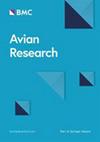Importance of surrounding landscape features in explaining wintering waterbird diversity and community assembly in Jiangsu's inland lake wetlands
IF 1.7
2区 生物学
Q1 ORNITHOLOGY
引用次数: 0
Abstract
As one of the important wintering areas along the East Asian–Australasian Flyway, wetlands in the Yangtze River floodplain face threats from land-use changes, yet its effects on wintering waterbirds at the landscape level remain understudied, impeding conservation practice. Here, using survey data collected across 14 inland lakes in Jiangsu Province in 2022, we calculated wintering waterbirds diversity (taxonomic, functional, phylogenetic) and assembly patterns (MPD/MNTD of functional and phylogenetic). Then, we interpreted satellite imagery of lake areas and buffer zones (5 km), and partitioned them into three land-use and landscape index categories (anthropogenic, ecological, and lake landscape). Finally, we employed multiple linear regression and hierarchical partitioning to explain the influence of landscape scales on wintering waterbird communities. Our results showed that the diversity and assembly of regional wintering waterbird communities tended to be consistent across taxonomic, functional, and phylogenetic dimensions. The standardized diversity indices indicated that functional assembly of communities tends to be clustered at both local and regional scale. In contrast, the phylogenetic structure showed a predominantly overdispersed pattern in most lakes at the local scale, while neutral processes dominated at the regional scale. Modeling showed that selected variables explained waterbird diversity and assembly well. Lake fragmentation increased species evenness but reduced other diversity indices, while landscape evenness was negatively associated with functional and phylogenetic assembly. Among anthropogenic factors, aquaculture ponds and impervious surfaces reduced all diversity dimensions, whereas cropland connectivity enhanced phylogenetic diversity. These factors had consistent effects on community assembly. For ecological variables, grassland area enhanced functional and phylogenetic diversity but led to more clustered functional assembly. Overall, maintaining the integrity and connectivity of lakes and their surrounding landscapes is essential for sustaining waterbird diversity and guiding wetland restoration.
江苏内陆湖湿地周边景观特征对越冬水鸟多样性和群落聚集的重要性
长江漫滩湿地是东亚-澳大拉斯候鸟重要的越冬区之一,面临着土地利用变化对水鸟越冬的威胁,但在景观层面对其影响的研究尚不充分,阻碍了保护实践。利用2022年江苏省14个内陆湖泊的调查数据,计算了越冬水鸟的多样性(分类、功能、系统发育)和组合模式(功能和系统发育的MPD/MNTD)。在此基础上,对湖区和5 km缓冲带的卫星影像进行了解译,并将其划分为3个土地利用和景观指数类别(人为、生态和湖泊景观)。最后,采用多元线性回归和分层划分方法分析了景观尺度对越冬水鸟群落的影响。结果表明,区域越冬水鸟群落的多样性和聚集性在分类、功能和系统发育维度上趋于一致。标准化多样性指数表明,群落的功能组合在地方和区域尺度上都趋向于聚集。系统发育结构在局部尺度上以过分散为主,在区域尺度上以中性过程为主。建模结果表明,选择的变量很好地解释了水鸟的多样性和聚集性。湖泊破碎化增加了物种均匀度,但降低了其他多样性指标,而景观均匀度与功能和系统发育组合呈负相关。在人为因素中,养殖池塘和不透水地表降低了所有多样性维度,而农田连通性提高了系统发育多样性。这些因素对社区聚集有一致的影响。在生态变量上,草地面积增加了功能多样性和系统发育多样性,但导致更多的聚类功能组合。总体而言,保持湖泊及其周边景观的完整性和连通性对于维持水鸟多样性和指导湿地恢复至关重要。
本文章由计算机程序翻译,如有差异,请以英文原文为准。
求助全文
约1分钟内获得全文
求助全文
来源期刊

Avian Research
ORNITHOLOGY-
CiteScore
2.90
自引率
16.70%
发文量
456
审稿时长
46 days
期刊介绍:
Avian Research is an open access, peer-reviewed journal publishing high quality research and review articles on all aspects of ornithology from all over the world. It aims to report the latest and most significant progress in ornithology and to encourage exchange of ideas among international ornithologists. As an open access journal, Avian Research provides a unique opportunity to publish high quality contents that will be internationally accessible to any reader at no cost.
 求助内容:
求助内容: 应助结果提醒方式:
应助结果提醒方式:


